
|

|
Plastics:
Macromolecular materials with varied application fields; polymers that are artificially manufactured by chemical techniques. Thus, these organic materials do not appear in nature. | | |
Chemical techniques for the manufacturing of plastics: One differentiates between polymerisation, polycondensation and polyaddition. Polymerisation:
The composition of simpler chemical compounds (=monomers) forming absolute homopolar compounds into polymer, chain-… |
|
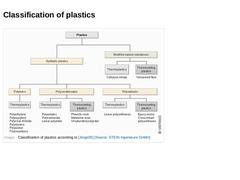
|

(Image: Classification of plastics according to [Jürge05] [Image: S&P GmbH]) |
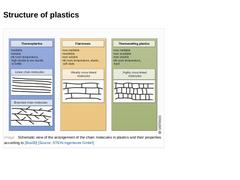
|

(Image: Schematic view of the arrangement of the chain molecules in plastics and their properties according to [Bos00] [Image: S&P GmbH]) |
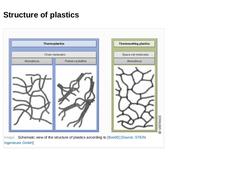
|

(Image: Schematic view of the structure of plastics according to [Bos00] [Image: S&P GmbH]) |
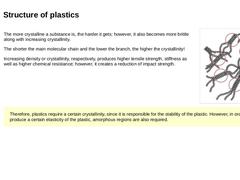
|

| (Image: Crystallinity of polyethylene according to [Bos00] [Jürge05])
The more crystalline a substance is, the harder it gets; however, it also becomes more brittle along with increasing crystallinity. The shorter the main molecular chain and the lower the branch, the higher the crystallinity! Increasing density or crystallinity, respectively, produces higher tensile strength, stiffness as well as higher chemical resistance; however, it creates a … |
|
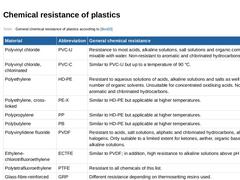
|

(Table: General chemical resistance of plastics according to [Bos00]) |
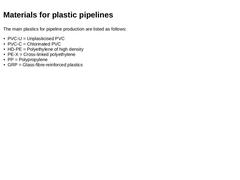
|

The main plastics for pipeline production are listed as follows: -
PVC-U = Unplasticised PVC
-
PVC-C = Chlorinated PVC
-
HD-PE = Polyethylene of high density
-
PE-X = Cross-linked polyethylene
-
PP = Polypropylene
-
GRP = Glass-fibre-reinforced plastics
|

|

|
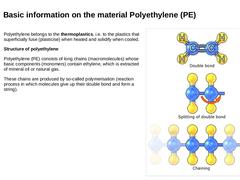
|

|
(Image: Polymerisation process – clearing of double bonds of carbon atoms of a monomer and forming into long chains (polymers))
Polyethylene belongs to the thermoplastics, i.e. to the plastics that superficially fuse (plasticise) when heated and solidify when cooled. Structure of polyethylene Polyethylene (PE) consists of long chains (macromolecules) whose basic components (monomers) contain ethylene, which is extracted of mineral oil or natural gas. |
|
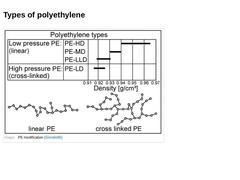
|

(Image: PE modification [Grondo95]) |
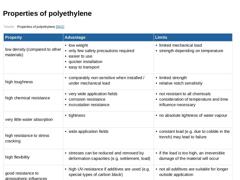
|

|
(Table: Properties of polyethylene [SKZ]) |
|

|

|
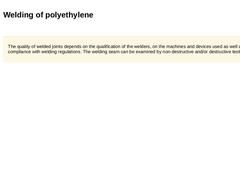
|

The quality of welded joints depends on the qualification of the welders, on the machines and devices used as well as the compliance with welding regulations. The welding seam can be examined by non-destructive and/or destructive testing. |
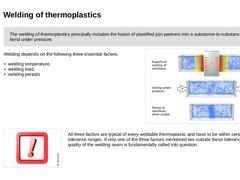
|

|
The welding of thermoplastics principally includes the fusion of plastified join partners into a substance-to-substance bond under pressure. |
|
(Image: General welding procedure of heated tool welding according to [SKZ] [Image: S&P GmbH])
Welding depends on the following three essential factors: -
welding temperature,
-
welding load,
-
welding periods
|
|
(Image: Attention!)
All three factors are typical of every weldable thermoplastic and have to be within … |
|

|

|
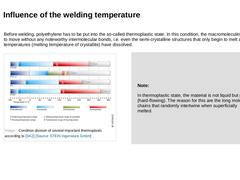
|

|
Before welding, polyethylene has to be put into the so-called thermoplastic state. In this condition, the macromolecules are free to move without any noteworthy intermolecular bonds, i.e. even the semi-crystalline structures that only begin to melt at higher temperatures (melting temperature of crystallite) have dissolved. |
|
(Image: Condition division of several important thermoplasts according to [SKZ] [Image: S&P GmbH]) |
Note: In thermoplastic state, … |
|

|

The length of the molecular chains has a strong influence on the weldability. Therefore, the different chain lengths should be as equal as possible in order to achieve homogeneous flowing properties. If there are very high molecular weights, as with PE 100, an ultra high-molecular polyethylene (PE- HD-UHMW), the chain reaches such a length that the molecular chains in thermoplastic state cannot slide down anymore because of the many entanglements … |
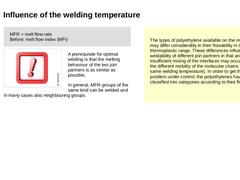
|

|
MFR = melt flow rate
Before: melt flow index (MFI) | |
The types of polyethylene available on the market may differ considerably in their flowability in the thermoplastic range. These differences influence the weldability of different join partners in that an insufficient mixing of the interfaces may occur due to the different mobility of the molecular chains (at the same welding temperature). In order to get this problem under control, the polyethylenes … |
|
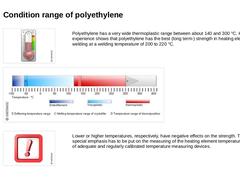
|

Polyethylene has a very wide thermoplastic range between about 140 and 300 °C. However, experience shows that polyethylene has the best (long term-) strength in heating element butt welding at a welding temperature of 200 to 220 °C. (Image: Condition range of polyethylene according to [SKZ] [Image: S&P GmbH]) Lower or higher temperatures, respectively, have negative effects on the strength. Therefore, special … |
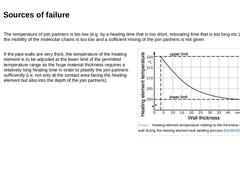
|

|
The temperature of join partners is too low (e.g. by a heating time that is too short, relocating time that is too long etc.) so that the mobility of the molecular chains is too low and a sufficient mixing of the join partners is not given. |
|
If the pipe walls are very thick, the temperature of the heating element is to be adjusted at the lower limit of the permitted temperature range as the huge material thickness requires a relatively long heating … |
|

|

|

|

The welding load serves to bring the plastified join partners into contact in such a way that the molecular chains are sufficiently mixed and that the semi-crystalline structures, which determine the strength of the polyethylene, can develop. The necessary welding load (specific jointing pressure) for polyethylene is determined by the DVS 2207-1 (German Welding Society) and has to be converted for the corresponding welding surfaces (load per surface). |

|

| (Image: Influence of the welding force during heating element butt welding – too low a jointing pressure)
Jointing pressure too low: lack of mixing of join partners | | (Image: Influence of the welding force during heating element butt welding - too high a jointing pressure)
Jointing pressure too high:
too much plastified material is pressed into the welding beads. This leads to a clash of colder layers and thus to an insufficient mixing and a reduction … |
|
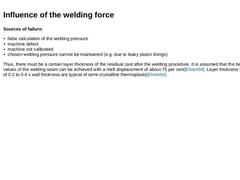
|

Sources of failure: -
false calculation of the welding pressure
-
machine defect
-
machine not calibrated
-
chosen welding pressure cannot be maintained (e.g. due to leaky piston linings)
Thus, there must be a certain layer thickness of the residual cast after the welding procedure. It is assumed that the best strength values of the welding seam can be achieved with a melt displacement of about 75 per cent [Ehren04]. Layer thickness values of cast of … |

|

|